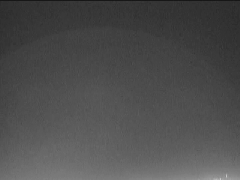[/caption]
Meteor showers are great fun. The streaks and flashes create a special type of astronomical fireworks. But there are some people out there who enjoy meteor showers in a different way. They don't watch the meteors. Instead, they watch the moon. There are fireworks there, too, in the form of explosions -- equivalent to about 100 pounds of TNT -- when meteors hit the lunar surface.
On August 9th, during the Perseid meteor shower, a couple of amateur astronomers fixed their cameras on the Moon and watched meteoroids slam into the lunar surface. Silent explosions produced flashes of light visible a quarter of a million miles away on Earth. It was a good night for "lunar Perseids." [caption id="attachment_17581" align="alignnone" width="447" caption="Meteor strike on the moon imaged by George Varros. "]
[/caption] "I love watching meteor showers this way," says George Varros, who recorded the impact shown above from his home in Mt. Airy, Maryland. The flash, which lit up a nighttime patch of Mare Nubium (the Sea of Clouds), was a bit dimmer than 7th magnitude, which Varros said was "an easy target for my 8-inch telescope and low-light digital video camera."
Hours later, another Perseid struck, on the western shore of Oceanus Procellarum (the Ocean of Storms). This time it was Robert Spellman of Azusa, California, who caught the flash. "It's exciting to witness these explosions in real time," he says. "I used a 10-inch telescope and an off-the-shelf Supercircuits video camera."
Spellman has a website
about his observations.
NASA's Meteoroid Environment Office
watches the moon during meteor showers, too. Rob Suggs at the Marshall Space Flight Center and his team have recorded more than 100 lunar explosions since 2005. "We monitor lunar meteors in support of NASA's return to the Moon," Suggs says. "The Moon has no atmosphere to protect the surface, so meteoroids crash right into the ground. Our program aims to measure how often that happens and answer the question, what are the risks to astronauts?"
But NASA's official lunar meteor observatories in Alabama and Georgia were both off-line on August 9, so the NASA team didn't see how many Perseids were hitting the Moon that night.
"This shows how amateur astronomers can contribute to our research," points out Suggs. "We can't observe the Moon 24-7 from our corner of the USA. Clouds, sunlight, the phase of the Moonâ€"all these factors limit our opportunities. A global network of amateur astronomers monitoring the Moon could, however, approach full coverage."
Suggs hopes other amateurs will take up this hobby of watching the moon during meteor showers, not only to improve NASA's lunar impact statistics, but also to support the agency's LCROSS mission: In 2009, the Lunar CRater Observation and Sensing Satellite (LCROSS) will intentionally dive into the Moon, producing a flash akin to a natural lunar meteor. Unlike natural meteoroids, which hit the Moon in random locations, LCROSS will carefully target a polar crater containing suspected deposits of frozen water. If all goes as planned, the impact will launch debris high above the lunar surface where astronomers can search the ejecta for signs of H2O. The impact flash (if not hidden by crater walls) and the debris plume may be visible to backyard telescopes on Earth.
Here's more details
on the LCROSS impact.
If you're interested in watching for meteor impacts on the moon, NASA has a FAQ page, and telescope tips.
News Source:
Science@NASA
 Universe Today
Universe Today
